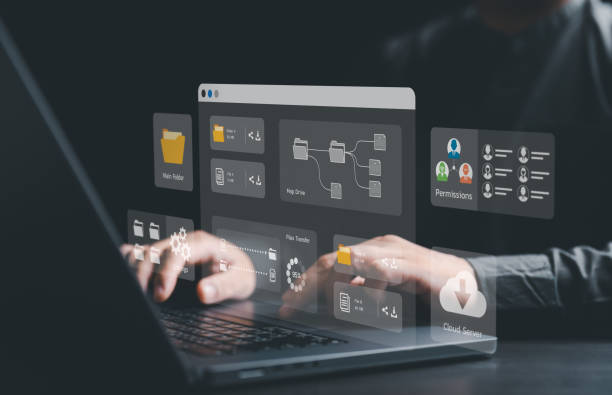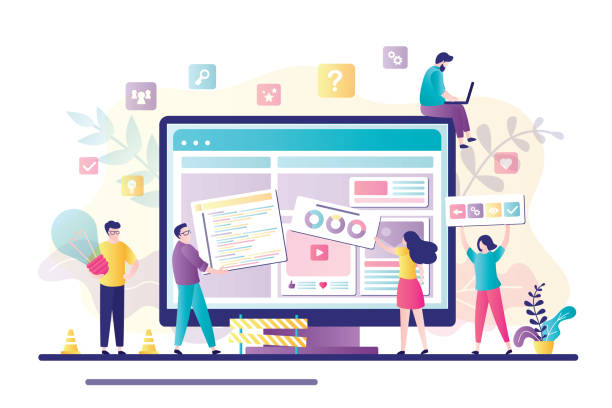The Importance of Multilingual Website Design in Today’s World
In the era of globalization, geographical boundaries are less of an obstacle for businesses and communications.
#Multilingual_website_design is no longer a luxury competitive advantage, but rather a necessity for any business aiming to operate beyond its domestic customers.
This approach allows you to send a global message and connect with audiences in their native language, which builds a greater sense of trust and intimacy.
A multilingual website not only helps increase #user_accessibility but also demonstrates respect for different cultures and languages.
This is a strategic investment for the future of your online presence.
Many businesses mistakenly believe that the goal of multilingual website design is achieved merely by translating content into English or a few common languages.
However, this is only a small part of the process.
A truly multilingual website must be designed technically, content-wise, and user-experience-wise to be optimized for every language and culture.
This means understanding linguistic and cultural nuances, adjusting content for different markets, and ensuring the site functions correctly in all languages.
This process is a comprehensive education for understanding the various dimensions of #international_marketing.
Analytically, results show that multilingual websites have higher conversion rates and keep users engaged for longer, as users prefer to shop or gather information in their own language.
Does your current e-commerce website design not generate the expected sales for you?
RasaWeb is an expert in professional e-commerce website design!
✅ An attractive and user-friendly site aimed at increasing sales
✅ High speed and security for an ideal shopping experience⚡ Get free consultation for online store design with RasaWeb!
SEO Benefits and Increased Global Traffic with a Multilingual Website
One of the biggest advantages of multilingual website design is a significant improvement in #international_SEO and an increase in #organic_traffic from all over the world.
Search engines like Google recognize multilingual content and display it to users in the appropriate language.
This allows your business to appear in search results in different countries, thereby providing access to new markets that were previously inaccessible to you.
Undoubtedly, this is a specialized and crucial step for any global #digital_marketing strategy.
Correct use of Hreflang tags, appropriate URL structure for each language (such as subdomains, subdirectories, or separate domains), and accurate keyword translation are all vital elements for multilingual SEO success.
These actions help search engines correctly localize your content for local target audiences.
Furthermore, by providing content in multiple languages, you can address the specific questions and needs of each market and thereby increase your brand’s credibility and trust globally.
This is a practical guide showing how a multilingual website design can help increase your customers and expand your business.
Analyses show that websites that are effectively multilingual often attract more traffic from non-English-speaking countries, which can lead to increased sales and revenue.
Technical Aspects of Multilingual Website Design
When it comes to multilingual website design, technical aspects are of paramount importance.
Choosing the appropriate URL structure for each language is one of the first and most crucial decisions.
Common options include using separate domains (example.de), subdomains (de.example.com), or subdirectories (example.com/de/).
Each of these options has its own advantages and disadvantages in terms of SEO, management, and costs.
This is a specialized part of the process that requires high precision to prevent future technical issues.
Another vital element is the correct implementation of the hreflang tag.
This tag informs search engines which version of the page is suitable for which language and geographical region, and prevents duplicate content issues.
#Multilingual_website_design must include this precise configuration.
Additionally, ensuring your CMS (Content Management System) compatibility with multilingual capabilities is essential.
Many popular CMSs like WordPress with suitable plugins, or Drupal and Joomla, offer strong multilingual support.
This educational section helps you make correct technical decisions for your project.
Next, a table is provided for a better understanding of the hreflang tag’s application:
| hreflang Usage Example | Explanation |
|---|---|
<link rel="alternate" hreflang="en" href="http://example.com/page.html" /> |
General English version of the page. |
<link rel="alternate" hreflang="en-GB" href="http://example.com/en-gb/page.html" /> |
English version for UK users. |
<link rel="alternate" hreflang="fa" href="http://example.com/fa/page.html" /> |
General Persian version of the page. |
<link rel="alternate" hreflang="x-default" href="http://example.com/" /> |
Default page for users whose language is not listed. |
Also, considering hosting and CDN issues to ensure high loading speed in different geographical regions is very important.
These are all part of a meticulous planning for an efficient #multicultural_site.
Content Translation and Localization Strategies
Translation is not merely rendering words from one language to another; rather, localization means adapting content to the culture, customs, and local language of the target audience.
This involves considering idioms, units of measurement, dates, currencies, and even colors and images that may have different meanings in various cultures.
A successful #multilingual_website_design delves deeply into these details.
Click here to preview your posts with PRO themes ››
To ensure high-quality translated content, the use of native-speaking translators or specialized translation agencies is recommended.
Machine translation can be a useful initial tool, but for sensitive or marketing content, the quality of human translation, which is familiar with cultural nuances, is unparalleled.
This is an educational content that emphasizes the importance of accuracy in translation.
Furthermore, a localization strategy must include keyword research for each language.
Keywords that are effective in one language may not be applicable in another or may have different search volumes.
This is an important analytical aspect that can significantly impact SEO performance.
Additionally, visual content and videos should also be localized to align with the cultural preferences of each region.
Providing thought-provoking and engaging content in each language can significantly increase user interaction.
For example, is a joke understood in the same way across different cultures? These questions make localization more complex yet more appealing.
Did you know that 85% of customers check your company’s website before any interaction?
With RasaWeb, build a corporate website that truly reflects your credibility.
✅ Increase customer credibility and trust
✅ Attract high-quality leads
⚡ Get free website design consultation
User Experience and Multilingual User Interface Design
One of the most important pillars of a successful multilingual website design is providing a seamless and optimized #user_experience (UX) for all languages.
This includes designing the user interface (UI) that allows users to easily select their desired language.
Typically, a clear button or dropdown menu for language selection is placed in the website’s header or footer.
This is a fundamental guide for usability.
Page layouts should be designed such that changing the language does not disrupt the design.
Some languages, such as Persian and Arabic, are written from right-to-left (RTL), while many other languages are left-to-right (LTR).
This difference requires responsive and flexible design that can correctly adjust text direction and UI elements.
Ensuring that all fonts are displayed correctly in all supported languages is also crucial.
These technical aspects must be carefully reviewed to provide an enjoyable and trouble-free user experience.
In addition, attention must be paid to #site_navigation, forms, error messages, and other interactive elements.
All these elements must be carefully translated and localized so that the user does not feel lost or unfamiliar at any stage.
This is an important step in building customer trust and satisfaction.
Designing a #multicultural_website goes beyond translating words; it means designing an inclusive experience where every user, regardless of their language or culture, feels comfortable and understood.
This demonstrates how a multilingual website design can truly serve users.
Choosing the Right Platform and Content Management System
Choosing an appropriate platform or #Content_Management_System (CMS) is one of the most important decisions in a multilingual website design project.
Many popular CMSs such as WordPress, Drupal, and Joomla offer multilingual capabilities through plugins or built-in modules.
WordPress, with plugins like WPML or Polylang, easily provides multilingual content management.
This explanatory section helps you make a more informed choice.
When choosing a CMS, pay attention to factors such as ease of use, SEO features, localization capabilities, and its support community.
Some platforms like Shopify for online stores, or Squarespace for simpler websites, also offer multilingual capabilities, but may have less flexibility in terms of SEO or customization.
This is an expert decision that should be made considering the long-term needs of your business.
Also, if your project is very large and complex, you may need a custom solution or the use of a Headless CMS, which provides more flexibility in delivering content to different languages and platforms.
Reviewing the opinions and experiences of other users and businesses in platform selection can be very helpful.
This is an educational content that helps you choose the right path for developing your multilingual website.
Ultimately, the platform you choose should have the ability to easily manage translations, update content in different languages, and ensure the correct functioning of all aspects of the website.
A correct choice can greatly simplify the process of maintaining and expanding an #international_site.
Common Challenges and Solutions in Multilingual Site Development
Although multilingual website design offers numerous benefits, this process also comes with challenges that need attention.
One of the biggest challenges is content and translation management.
Ensuring that all content, including texts, images, videos, and even contact forms, are correctly translated and localized can be time-consuming and costly.
A thought-provoking question at this stage could be: How can we ensure translation quality at high volumes?
Click here to preview your posts with PRO themes ››
Another challenge is technical issues related to SEO.
Incorrect use of hreflang tags, problems in URL structure, or errors in selecting translated keywords can harm your site’s SEO.
To overcome these challenges, collaboration with international SEO specialists and the use of appropriate tools for hreflang management are recommended.
This section provides a comprehensive analysis of problems and solutions related to #multilingual_sites.
Also, site loading speed and server performance for users in different geographical regions can be a challenge.
Using a CDN (Content Delivery Network) and optimizing images and other files can help improve speed.
Finally, continuous maintenance and updating of content in all languages is also an operational challenge that requires precise planning.
These are all part of a specialized and complex process that requires special attention to ensure a #multicultural_website functions optimally.
Next, a table is provided to compare common translation issues and their solutions:
| Common Problem | Solution |
|---|---|
| Literal and unnatural translation | Use native-speaking translators and localize content. |
| Keyword mismatch with the target language | Separate keyword research for each language and region. |
| hreflang technical issues | Thorough review of hreflang implementation and use of validation tools. |
| Low loading speed for international users | Use of CDN and content optimization for the web. |
Marketing and Advertising for Multilingual Websites
After multilingual website design, the next stage is #marketing and advertising it in target markets.
Digital marketing strategies must be localized for each language and region.
This includes Google Ads campaigns, social media advertising, and SEO.
A news-oriented approach in this area could include the successes of international companies in multilingual marketing.
For example, while Facebook might be popular in some countries, in others, platforms like WeChat in China or VK in Russia are preferred.
Understanding these differences and adjusting advertising campaigns based on popular local platforms is crucial.
This is specialized content for marketers looking to expand globally.
Content marketing also plays a key role in the success of a multilingual website.
Producing engaging and relevant content tailored to the needs of each market can increase organic traffic and strengthen your brand’s credibility.
This includes blogs, videos, infographics, and case studies produced in the local language and considering the interests of that community.
Even email marketing must be localized to align with the tone and preferences of each culture.
This is an analytical approach for planning international marketing campaigns that helps the success of your #multicultural_site.
A comprehensive and localized advertising strategy can be the difference between an online presence and global market dominance.
Did you know that 85% of customers check your company’s website before any interaction?
With RasaWeb, build a corporate website that truly reflects your credibility.
✅ Increase customer credibility and trust
✅ Attract high-quality leads
⚡ Get free website design consultation
Measuring Success and Analyzing Multilingual Website Performance
After implementation and marketing, measuring success and analyzing multilingual website performance is essential.
Tools like Google Analytics allow tracking traffic based on language and geographical region.
This data helps you understand which languages and countries bring the most traffic to your site and what user behavior is like in each language.
This is an educational and analytical content.
Metrics to track include: Page Views, Bounce Rate, Time on Site, Conversion Rate, and traffic sources.
By comparing these metrics across different languages, you can identify the strengths and weaknesses of your multilingual website design strategy.
For example, if the bounce rate in a specific language is high, it might indicate problems with translation quality or inadequate content localization.
This is an important step for continuous optimization.
Furthermore, monitoring keyword rankings in search engines for each language and region provides valuable information about the effectiveness of your SEO strategy.
Local user feedback through surveys or user behavior tracking tools can also provide deep insights.
This data helps you make more informed decisions to improve user experience and increase your website’s efficiency in different markets.
Continuous performance measurement is key to the sustainable success of a #multicultural_website in today’s competitive world.
Continuous Maintenance and Updates for a Multilingual Website
The process of multilingual website design does not end with its launch; continuous maintenance and updates are of paramount importance.
Your website content must be regularly updated in all languages to provide accurate and relevant information to users.
This includes updating product information, company news, blog articles, and any changes in your services or offerings.
This is a vital aspect that is often overlooked.
Click here to preview your posts with PRO themes ››
Also, monitoring the technical performance of the site in all languages and resolving any bugs or SEO issues, including ensuring the correctness of hreflang tags and adequate loading speed, is essential.
This is a practical guide for maintaining your site’s health.
Over time, there may be a need to add new languages or expand into new markets, which requires precise planning and correct execution from both technical and content aspects.
Customer support in different languages should also be considered.
This includes providing communication channels such as email, live chat, or phone in the local language.
A strong support system can significantly improve user experience and increase customer loyalty.
This is a specialized part of customer relationship management.
Maintaining a multilingual website is a continuous process that requires a commitment to providing the best experience for your global users.
With proper planning and execution, you can ensure that your site remains efficient and appealing.
Frequently Asked Questions
| No. | Question | Answer |
|---|---|---|
| 1 | What is multilingual website design? | Multilingual website design means creating a website whose content is available to users in several different languages. This is usually done through a simple user interface for language switching. |
| 2 | Why should we design a multilingual website? | Multilingual website design helps you reach a wider audience around the world, provide a better user experience for international users, and improve your global SEO. |
| 3 | What are the main methods for implementing multilingualism on a website? | The main methods include using subdomains (subdomain), subdirectories (subdirectory), or URL parameters for each language, as well as using completely separate domains for each language. |
| 4 | For SEO, is it better to use a subdirectory or a subdomain? | In terms of SEO, both subdirectory and subdomain methods can be effective. However, many SEO specialists prefer subdirectories due to better transfer of main domain authority. |
| 5 | What are the important tips for translating multilingual site content? | Translation should be done by native translators, content should be localized (localization) in addition to translation to match the target audience’s culture, and pure machine translation should be avoided. |
| 6 | What is the role of the hreflang tag in multilingual site SEO? | The hreflang tag helps search engines like Google display the correct language and regional version of a page to appropriate users, which also prevents duplicate content issues. |
| 7 | Can a website be made multilingual without coding? | Yes, in Content Management Systems (CMS) like WordPress, powerful plugins such as WPML or Polylang exist that allow making a website multilingual without the need for coding. |
| 8 | What are the challenges of multilingual website design? | Challenges include translation management, content localization, adherence to SEO principles for each language, technical support for different languages, and ensuring design consistency across different languages. |
| 9 | What is the difference between translation and localization? | Translation is merely rendering words from one language to another, while localization involves adapting content to the culture, customs, currency, dates and times, and even appropriate colors for the target audience. |
| 10 | What is the best user experience (UX) for language switching? | A clear and accessible language switcher (usually in the header or footer), using the language name instead of flags (due to regional diversity), and maintaining the user’s position after changing language are important UX considerations. |
And other services of Rasa Web Advertising Agency in the field of advertising
Smart Advertising Campaign: Designed for businesses seeking digital branding through user experience customization.
Smart Marketing Automation: Designed for businesses looking to attract customers through SEO-driven content strategies.
Smart SEO: A dedicated service for growth in campaign management based on real data.
Smart Custom Software: Revolutionize customer behavior analysis with the help of marketing automation.
Smart SEO: Professional optimization for online growth using key page optimization.
And over hundreds of other services in the field of internet advertising, advertising consulting, and organizational solutions
Internet Advertising | Advertising Strategy | Advertorials
Resources
Advantages of Multilingual Website Design for Businesses
Comprehensive Guide to Multilingual Website Design
Key SEO Tips for Multilingual Websites
How to Reach Global Audiences with a Multilingual Website?
? To reach the pinnacle in the digital world, Rasaweb Afarin Digital Marketing Agency paves the way for your business’s success by providing comprehensive services including professional website design, SEO, and online advertising.
📍 Tehran, Mirdamad Street, next to Central Bank, Southern Kazeroun Alley, Ramin Alley, No. 6














